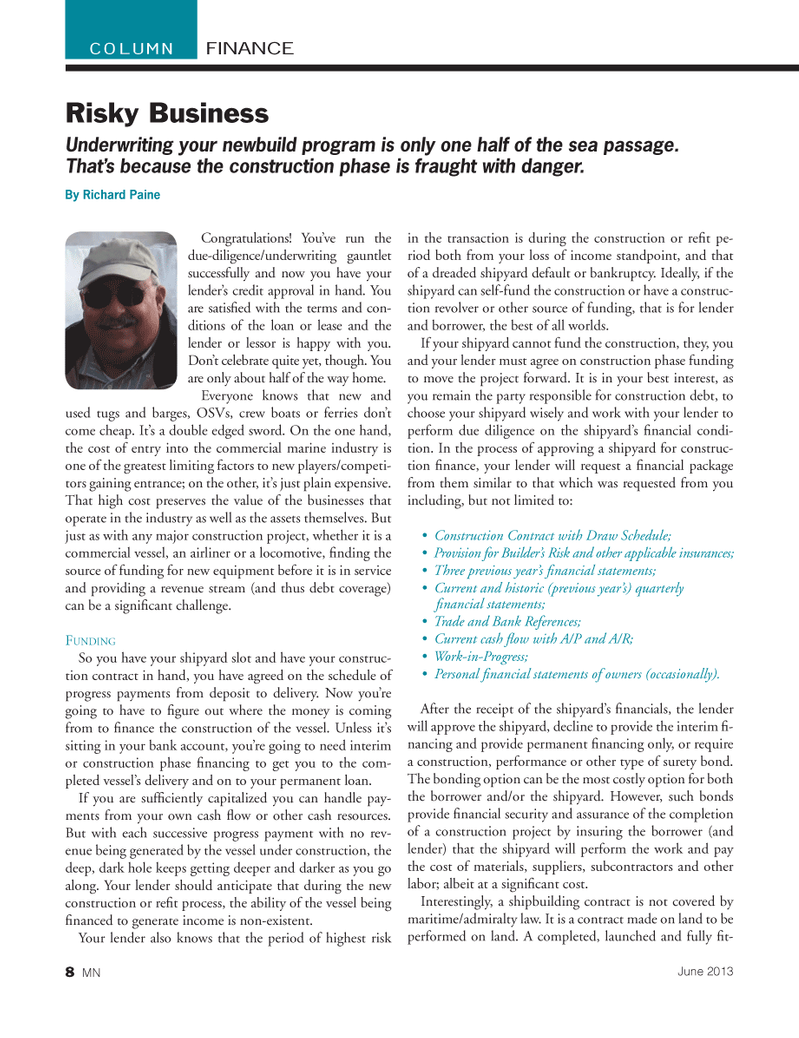
Page 8: of Marine News Magazine (June 2013)
Dredging & Marine Construction
Read this page in Pdf, Flash or Html5 edition of June 2013 Marine News Magazine
Congratulations! You?ve run the due-diligence/underwriting gauntlet successfully and now you have your lender?s credit approval in hand. You are satis ed with the terms and con- ditions of the loan or lease and the lender or lessor is happy with you. Don?t celebrate quite yet, though. You are only about half of the way home. Everyone knows that new and used tugs and barges, OSVs, crew boats or ferries don?t come cheap. It?s a double edged sword. On the one hand, the cost of entry into the commercial marine industry is one of the greatest limiting factors to new players/competi- tors gaining entrance; on the other, it?s just plain expensive. That high cost preserves the value of the businesses that operate in the industry as well as the assets themselves. But just as with any major construction project, whether it is a commercial vessel, an airliner or a locomotive, nding the source of funding for new equipment before it is in service and providing a revenue stream (and thus debt coverage) can be a signi cant challenge. FUNDINGSo you have your shipyard slot and have your construc- tion contract in hand, you have agreed on the schedule of progress payments from deposit to delivery. Now you?re going to have to gure out where the money is coming from to nance the construction of the vessel. Unless it?s sitting in your bank account, you?re going to need interim or construction phase nancing to get you to the com- pleted vessel?s delivery and on to your permanent loan. If you are suf ciently capitalized you can handle pay- ments from your own cash ow or other cash resources. But with each successive progress payment with no rev- enue being generated by the vessel under construction, the deep, dark hole keeps getting deeper and darker as you go along. Your lender should anticipate that during the new construction or re t process, the ability of the vessel being nanced to generate income is non-existent. Your lender also knows that the period of highest risk in the transaction is during the construction or re t pe- riod both from your loss of income standpoint, and that of a dreaded shipyard default or bankruptcy. Ideally, if the shipyard can self-fund the construction or have a construc- tion revolver or other source of funding, that is for lender and borrower, the best of all worlds. If your shipyard cannot fund the construction, they, you and your lender must agree on construction phase funding to move the project forward. It is in your best interest, as you remain the party responsible for construction debt, to choose your shipyard wisely and work with your lender to perform due diligence on the shipyard?s nancial condi- tion. In the process of approving a shipyard for construc- tion nance, your lender will request a nancial package from them similar to that which was requested from you including, but not limited to: Construction Contract with Draw Schedule; Provision for Builder?s Risk and other applicable insurances; Three previous year?s nancial statements; Current and historic (previous year?s) quarterly nancial statements; Trade and Bank References; Current cash ow with A/P and A/R; Work-in-Progress; Personal nancial statements of owners (occasionally). After the receipt of the shipyard?s nancials, the lender will approve the shipyard, decline to provide the interim -nancing and provide permanent nancing only, or require a construction, performance or other type of surety bond. The bonding option can be the most costly option for both the borrower and/or the shipyard. However, such bonds provide nancial security and assurance of the completion of a construction project by insuring the borrower (and lender) that the shipyard will perform the work and pay the cost of materials, suppliers, subcontractors and other labor; albeit at a signi cant cost. Interestingly, a shipbuilding contract is not covered by maritime/admiralty law. It is a contract made on land to be performed on land. A completed, launched and fully t-FINANCECOLUMNRisky Business Underwriting your newbuild program is only one half of the sea passage. That?s because the construction phase is fraught with danger. By Richard Paine 8 MNJune 2013MN June2013 Layout 1-17.indd 8MN June2013 Layout 1-17.indd 85/30/2013 11:04:36 AM5/30/2013 11:04:36 AM

 7
7

 9
9
